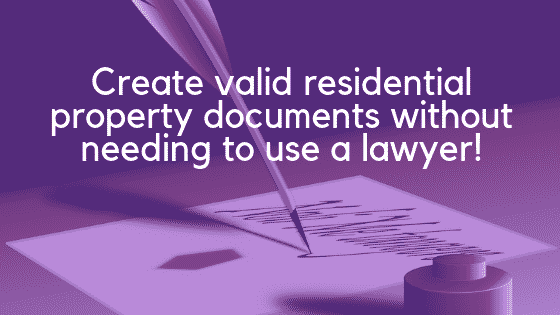Residential Property
Categories
Business
- Business Legal Templates
- Commercial Contract Templates
- Commercial Property
- Compliance
- Confidentiality Agreements
- Copyright
- Debt Recovery Letters
- Ecommerce and Internet
- Employment Contract Templates
- Health and Safety
- Human Resources Templates
- Intellectual Property Agreements
- Non-Disclosure
- Trademarks
Personal
-
Anti-Social Behaviour Policy£19.95
Our anti-social behaviour policy is for use with residential tenants in the UK. It supplements an assured shorthold tenancy agreement.
-
Assured Shorthold Tenancy Agreement£19.95
Use an Assured Shorthold Tenancy Agreement for residential tenancies.
-
Deed of Covenant for a Lease£24.95
Use our deed of covenant for a lease where the lease requires this is done for the benefit of the landlord when one tenant is selling the remainder of the long leasehold property.
-
Deed of Gift£34.95
Use this deed of gift template to transfer property of all types, such as money, shares and freehold property. Over 500 sold!
-
Inventory£19.95
This is our inventory template, which is for residential tenancies, whether furnished or not. You can use it to include a photographic schedule of condition.
-
Licence to Assign a Residential Lease£29.95
Our Licence to Assign template is for use by a tenant / owner of a long lease of residential premises who is wishing to sell (i.e. assign) the remainder of the term of the long lease to a new tenant.
-
Licence To Occupy Residential Property£24.95
Our licence agreement for letting part of a residential property. Over 600 sold!
-
Licence to Occupy Residential Property with Guarantor£29.95
This is our popular licence to occupy residential property, but with the added facility to have a guarantor of the tenant's obligations.
-
Lodger Agreement£19.95
Use this lodger agreement template to put in place a tenancy contract with your lodger easily.
-
Lodger Agreement With Guarantor£22.50
Our Lodger Agreement template with provision to include a guarantor.
-
Notice of Severance of Joint Tenancy£19.95
A template notice for severing a joint tenancy of a UK property. It then becomes owned on a tenants-in-common basis.
-
Personal Guarantee£34.95
A personal guarantee template for a loan, debt or other obligation. Use it also for a parent company guarantee.
-
Pre Tenancy Agreement£7.95
Use this template to agree the basic terms whilst you wait to put in place a full tenancy agreement.
-
Rent Arrears Letter£5.95
Our rent arrears letter template for sending to a tenant once payment of rent has become overdue. Reusable at no extra cost.
Residential Property – Tenancy Templates For Landlords
Welcome to our residential property section. A tenancy agreement is contract between a landlord and a tenant and sets out the contractual rights and obligations of each party. The landlord has to give their tenant a tenancy agreement and, depending on the nature of the tenancy, the law may imply certain provisions into the contract. We set out below much more detail about tenancy agreements and tenancy law, so that you can be sure to know which type of document suits your situation.
There are three kinds of tenancy agreements in law:
1. The Assured Shorthold Tenancy agreement – The common type of modern tenancy agreement used by most landlords for letting all or part of a residential property. (We have a template for this type.)
2. The Assured Tenancy agreement – for Wikipedia’s explanation of these longer term tenancy agreements which give the tenant stronger rights, see: https://en.wikipedia.org/wiki/Assured_tenancy. They are more commonly offered bodies like housing associations to their long-term residents; and
3. The Regulated Tenancy agreement – these are pretty rare now, as they only apply to tenancies under the 1977 Rent Act (or before) that were created before 17 January 1989. They were for longer-term occupation and gave the tenant additional rights, e.g. security of tenure and increases in rent had to be fair.
Both the landlord and tenant(s) must sign any tenancy agreement. Once both have signed it, the tenancy agreement will be legally binding.
The Range Of Residential Property Agreements
Landlords are able to use their own tenancy agreements rather than that of an expensive high-street solicitors. You can download our DIY tenancy agreement for a cheaper alternative.
Legalo has a full range of residential property templates available to you. You can re-use them again and again, but you only pay once for one of our templates. They are therefore excellent value for money. They come with helpful guides, containing tips on how to use them and explaining each clause. It could not be easier.
Typical Terms in a Tenancy Agreement
The terms and clauses in a typical tenancy agreement include:
- Rent – when this will be paid;
- Deposit – the amount and where it will be held, what conditions it will be returned;
- The permitted use of property by tenant;
- Subletting – no subletting is to be done by tenant;
- Repairs and alterations by the landlord and tenant;
- Utilities and out-goings to be paid by tenant;
- Landlord’s covenants to the tenant;
- Default of tenant – what will happen if the tenant is in arrears;
- Guarantee and indemnity – whether there is a guarantor for the tenant’s rent;
- Reservation of the landlord’s right to enter the property;
- Expiry of the tenancy – the order of dealings and the return of the keys to the landlord and the return of the deposit to the tenant.
The terms listed above are the basic provisions included in general tenancy agreements. You can easily amend the terms of our templates in a number of ways to suit your needs. For some of the more frequent amendments, we might have a template already adapted to suit. For example, if there was a guarantor for the tenant, you will see that we already have (a) a licence to occupy and (b) a lodger agreement with those guarantee provisions built in.
